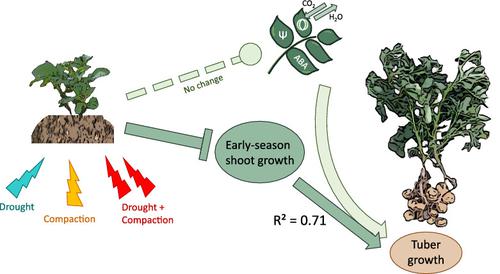当前位置:
X-MOL 学术
›
Ann. Appl. Biol.
›
论文详情
Our official English website, www.x-mol.net, welcomes your feedback! (Note: you will need to create a separate account there.)
Agronomic and physiological responses of potato subjected to soil compaction and/or drying
Annals of Applied Biology ( IF 2.6 ) Pub Date : 2021-01-18 , DOI: 10.1111/aab.12675 Katharina Huntenburg 1 , Ian C. Dodd 1 , Mark Stalham 2
Annals of Applied Biology ( IF 2.6 ) Pub Date : 2021-01-18 , DOI: 10.1111/aab.12675 Katharina Huntenburg 1 , Ian C. Dodd 1 , Mark Stalham 2
Affiliation

|
Compact and dry soils impede root growth and restrict plant water availability, respectively, potentially causing leaf water deficit. Although both stresses likely co‐occur in the field and limit yield, little is known about their combined impact on plant growth and physiology over a whole season, especially in a tuberous crop like potato. Field‐grown potato (Solanum tuberosum L. var. 'Maris Piper') was exposed to factorial combination of deficit irrigation (watering when soil moisture deficit reached 60 vs. 25 mm) and soil compaction (compacted with heavy machinery vs. uncompacted), with plant growth and leaf physiology measured weekly. Shoot growth was restricted by adverse soil conditions, while leaf water status, photosynthesis rates and leaf abscisic acid (ABA) levels did not vary significantly between treatments. Across all treatments, final yield was linearly correlated (R2 = 0.71) to mid‐season shoot biomass. Compared to well‐watered plants growing in loose soil, soil compaction, deficit irrigation and their combination decreased final tuber yield similarly, by 23%–34%. Surprisingly, tuber size distribution was more dependent on irrigation management than on soil strength. Plants exposed to deficit irrigation produced more, smaller potatoes than their respective control. Thus, low soil water availability and/or compact soil caused these field‐grown potatoes to restrict shoot growth rather than limit leaf gas exchange. Further research is needed to understand the role of hormonal signalling in regulating tuber growth when plants are exposed to compact and dry soils.
中文翻译:

土壤压实和/或干燥对马铃薯的农艺和生理响应
致密和干燥的土壤分别阻碍根系生长并限制植物的水分利用,从而可能导致叶片缺水。尽管两种胁迫都可能在田间同时发生并限制产量,但对于它们整个季节对植物生长和生理的综合影响知之甚少,尤其是在马铃薯等块茎作物中。田间种植的马铃薯(马铃薯)L.var。“马里斯·派珀(Maris Piper)”经受了缺水灌溉(土壤水分亏缺达到60毫米与25毫米时浇水)和土壤压实(重型机械与未压实的压实)的因子组合,每周都要测量植物的生长和叶片生理。在不利的土壤条件下,枝条的生长受到限制,而各处理之间的叶片水分状况,光合作用速率和叶片脱落酸(ABA)水平却没有显着变化。在所有处理中,最终产量均呈线性相关(R 2= 0.71)到季节中期新梢生物量。与生长在疏松土壤上的水养植物相比,土壤压实,亏水灌溉及其组合使最终块茎产量同样降低了23%–34%。出人意料的是,块茎大小分布更依赖灌溉管理而不是土壤强度。进行亏缺灌溉的植物生产的马铃薯要比各自的对照种植的马铃薯小得多。因此,土壤水分利用率低和/或土壤密实导致这些田间种植的马铃薯限制了芽的生长,而不是限制了叶片气体的交换。当植物暴露于致密干燥的土壤中时,需要进一步的研究来了解激素信号在调节块茎生长中的作用。
更新日期:2021-03-19
中文翻译:

土壤压实和/或干燥对马铃薯的农艺和生理响应
致密和干燥的土壤分别阻碍根系生长并限制植物的水分利用,从而可能导致叶片缺水。尽管两种胁迫都可能在田间同时发生并限制产量,但对于它们整个季节对植物生长和生理的综合影响知之甚少,尤其是在马铃薯等块茎作物中。田间种植的马铃薯(马铃薯)L.var。“马里斯·派珀(Maris Piper)”经受了缺水灌溉(土壤水分亏缺达到60毫米与25毫米时浇水)和土壤压实(重型机械与未压实的压实)的因子组合,每周都要测量植物的生长和叶片生理。在不利的土壤条件下,枝条的生长受到限制,而各处理之间的叶片水分状况,光合作用速率和叶片脱落酸(ABA)水平却没有显着变化。在所有处理中,最终产量均呈线性相关(R 2= 0.71)到季节中期新梢生物量。与生长在疏松土壤上的水养植物相比,土壤压实,亏水灌溉及其组合使最终块茎产量同样降低了23%–34%。出人意料的是,块茎大小分布更依赖灌溉管理而不是土壤强度。进行亏缺灌溉的植物生产的马铃薯要比各自的对照种植的马铃薯小得多。因此,土壤水分利用率低和/或土壤密实导致这些田间种植的马铃薯限制了芽的生长,而不是限制了叶片气体的交换。当植物暴露于致密干燥的土壤中时,需要进一步的研究来了解激素信号在调节块茎生长中的作用。


























 京公网安备 11010802027423号
京公网安备 11010802027423号